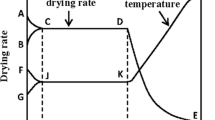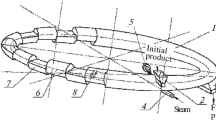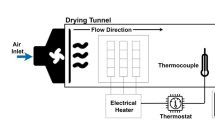Abstract
The effectiveness of internal heating for enhancing the drying of molded ceramics is evaluated by both modeling and experiments. In the theoretical analysis, three dimensional drying-induced strain–stress are modeled, and the numerical solutions show that the internal heating generates lower internal stress than continuous convective heating or intermittent convective heating. Microwave drying is examined experimentally to study the effect of internal heating on the drying behavior of a wet sample of a kaolin slab. The drying behavior is compared among three modes: microwave heating, hot air heating and radiation heating. The transient behavior of temperatures in microwave drying is quite different from conventional drying by external heating. In particular, the temperature of the slab drops once in the progress of drying. This phenomenon cannot be predicted adequately by a simple model of one-dimensional heat conduction and moisture diffusion accompanied with an internal heat generation rate given as a linear function of the moisture content. It should be noted that the temperature behavior takes place due to the combined interactions with internal evaporation of moisture by rise in internal vapor pressure and shift of impedance or interference in the applicator. Microwave heating with a constant power above 100 W results in sample breakage due to the internal vapor pressure. However, if the power is dynamically controlled so as to maintain the temperature less than the boiling point of water, the drying succeeds without any crack generation until completion with a significantly faster drying rate than drying in convective heating or in the oven.
Similar content being viewed by others
Abbreviations
- Bi :
-
Biot number [ − ]
- C 0 :
-
Initial moisture content defined by water weight per unit volume of layer [kg/m3]
- C*:
-
Dimensionless moisture content normalized by initial moisture content [ − ]
- c p :
-
Specific heat of layer [J/(kg · K)]
- c pw :
-
Specific heat of water [J/(kg · K)]
- f v :
-
Ratio of overall mass transfer coefficient between interface and air to that between surface and air [ − ]
- H a :
-
Humidity of air [kg-H2O/kg-dry air]
- H s :
-
Saturated humidity at surface temperature of layer [kg-H2O/kg-dry air]
- Le :
-
Lewis number [ − ]
- Q*:
-
Dimensionless internal heat generation rate [ − ]
- Q 0*:
-
Dimensionless internal heat generation rate of sample with initial moisture content [ − ]
- r w :
-
Latent heat of water evaporation [J/kg]
- T :
-
Local temperature [K]
- T 0 :
-
Initial temperature [K]
- T a :
-
Air temperature [K]
- \(\bar{T}\) :
-
Average temperature of sample [K]
- \(T*\) :
-
Dimensionless temperature normalized by initial temperature [ − ]
- T a *:
-
Air temperature normalized by initial temperature [ − ]
- V :
-
Volume of a slab [m3]
- w 0 :
-
Initial moisture content of a slab with dry basis [kg-H2O/kg-dry solid]
- \(\overline{w}\) :
-
Average moisture content of a slab with dry basis [kg-H2O/kg-dry solid]
- x*:
-
Coordinate in depth direction (dimensionless depth from surface normalized by thickness of layer) [ − ]
- x e *:
-
Dimensionless depth of interface from surface [ − ]
- θ:
-
Dimensionless time defined as Fourier number [ − ]
- ρ:
-
Density of layer [kg/m3]
- \(\phi_{1}\) :
-
Correction factor defined by ratio of thermal diffusivity in dry layer to wet layer [ − ]
- \(\phi_{2}\) :
-
Correction factor defined by ratio of thermal conductivity in dry layer to wet layer [ − ]
- φ:
-
Proportional constant in Eq. (10) [ − ]
References
Araszkiewicz M., Koziol A., Oskwarek A., Lupinski M. (2004). Microwave drying of porous materials. Dry. Technol. 22(10):2331–2341
Di P., Chang D.P.Y., Dwyer H.A. (2000). Heat and mass transfer during microwave steam treatment of contaminated soils. J. Environ. Eng. 126(12):1108–1115
Gong Z.X., Mujumdar A.S., Itaya Y., Mori S., Hasatani M. (1998). Drying of clay and nonclay media: Heat and mass transfer and quality aspects. Dry. Technol. 16(6):1119–1152
Islam Md. R., Ho J.C., Mujumdar A.S. (2003). Simulation of liquid diffusion-controlled drying of shrinking thin slabs subjected to multiple heat sources. Dry. Technol. 21(3):413–438
Itaya Y., Taniguchi S., Hasatani M. (1997). A numerical study of transient deformation and stress behavior of a clay slab during drying. Dry. Technol. 15(1):1–21
Itaya Y., Mori S., Hasatani M. (1999). Effect of intermittent heating on drying-Induced strain–stress of molded clay. Dry. Technol. 17(7&8):1261–1271
Itaya Y., Okouchi K., Mori S. (2001). Effect of heating modes on internal strain–stress formation during drying of molded ceramics. Dry. Technol. 19(7):1491–1504
Itaya, Y., Uchiyama, S., Cabrido, E.F., Hatano, S., Mori, S.: Uniformity of microwave field intensity by random reflection in a fluidized bed of electrically conductive beads. Kagaku Kogaku Ronbunshu (J. Chem. Eng. in Japanese) 29(3), 339–344 (2003)
Kowalski S.J., Rybicki A. (2004). Qualitative aspect of convective and microwave drying of saturated porous materials. Dry. Technol. 22(5):1173–1189
Kowalski S.J., Rajewska K., Rybicki A. (2004). Mechanical effects in saturated capillary-porous materials during convective and microwave drying. Dry. Technol. 22(10):2291–2308
Lehne M., Barton G.W., Langrish T.A.G. (1999). Comparison of experimental and modelling studies for the microwave frying of ironbark timber. Dry. Technol. 17(10):2219–2235
Liu F., Turner I.W., Bialkowski M.E. (1994). A finite-difference time-domain simulation of the power density distribution in a dielectric loaded microwave cavity. J. Microwave Power Electromag. Energy 29(3):138–148
Perre, P., Turner, I.W.: A complete coupled model of the combined microwave and convective drying of softwood in an oversized waveguide. Proceedings of the 10th International Drying Symposium (IDS’96), Krakow, Poland, vol. A, pp. 183–194 (1996)
Turner I.W., Jolly P.G. (1991). The modelling of combined microwave and convective drying of a wet porous material. Drying Technology 9(5):1209–1270
Turner, I.W.: A study of the power density distribution generated during the combined microwave and convective drying of softwood. Proceedings of the 9th International Drying Symposium (IDS’94), Gold Coast, Australia, pp. 89–111 (1994)
Author information
Authors and Affiliations
Corresponding author
Rights and permissions
About this article
Cite this article
Itaya, Y., Uchiyama, S. & Mori, S. Internal Heating Effect and Enhancement of Drying of Ceramics by Microwave Heating with Dynamic Control. Transp Porous Med 66, 29–42 (2007). https://doi.org/10.1007/s11242-006-9020-4
Received:
Accepted:
Published:
Issue Date:
DOI: https://doi.org/10.1007/s11242-006-9020-4




